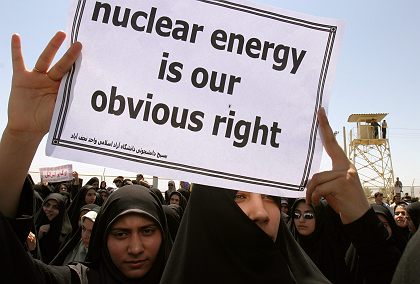Iran Nuclear Talks Deadline Extended
Iran nuclear deal
LONDON: Iran and the P5+1 (namely China, France, Russia, the United Kingdom, and the United States, plus Germany) will keep negotiating past Tuesday's deadline for a long-term nuclear agreement.
“We are continuing to negotiate for the next couple of days," EU foreign policy chief Federica Mogherini said. We're frankly more concerned about the quality of the deal than we are about the clock, though we also know that difficult decisions won't get any easier with time," spokeswoman for the U.S. delegation, Marie Harf, said.
The US and Iran have already reached a major breakthrough. In April this year, Iran and the P5+1 agreed on a framework agreement on Iran’s nuclear programme.
Again, in contrast with Greece where no one knows what an agreement -- if it is even reached -- between Greece and its creditors will look like, the Iran nuclear framework agreement provides an insight into what the final deal will look like.
Here is what we know thus far:
Simply put, the trouble is over Iran’s capacity to build a nuclear bomb. Iran insists that its nuclear programme is for peaceful purposes, whereas the UN, European Union, the US, and others have all imposed sanctions on the country because well, they don’t believe Tehran’s claim. The negotiations are centred around lifting these sanctions in exchange for Iran agreeing to curbs and limitations to its nuclear programme.
The process has not been easy because the US and others want Iran to prove that it can stuck to the curbs and restrictions before they lift sanctions gradually over time, whereas Iran’s position was that sanctions needed to be lifted immediately as the country needs economic relief and that it should not be levelled with more sanctions when it is in fact complying.
To understand what sort of curbs and restrictions the US and others have been demanding, a brief physics class is necessary.
There are two types of radioactive materials of consequence here: uranium and plutonium. For each, the process begins with enriching uranium ore. Uranium mined from the earth contains less than 1 percent of U-235 -- the isotope that is used to both fuel reactors and manufacture atom bombs. Centrifuges are needed to separate the isotope from the uranium -- a process defined as enrichment of uranium. For plutonium, the process involved irridating uranium in a nuclear reactor, thereby transforming some of the uranium into plutonium.
(Source: The New York Times)
Now that the physics has been established, here is the problem specific to Iran.
Problem Number 1: When uranium is enriched, the centrifuges are used to raise U-235 concentrations. In the west, most power reactors use uranium enriched up to 5 percent. Bomb grade is above 90 percent. Iran has thus far been enriching uranium up to 20 percent.
Problem Number 2: Iran has a stockpile of this low-enriched uranium (for peaceful purposes, they maintain). The problem is that the low-enriched uranium could be fed back into centrifuges and gradually made into highly enriched uranium -- and obviously, the US and others want to make sure that cannot happen.
Problem Number 3: Iran’s “Breakout Time”: “Breakout Time” refers to the amount of time it would take Iran to build a nuclear bomb if it decides to do so. Currently, if Iran’s leaders wake up tomorrow and decide they want a nuke in their hands, it would -- according to a US fact sheet -- take the country two-three months to be able to do so. The US and others want to extend this “breakout time.”
What has been agreed to?
A number of things have been agreed to that relate to the problems above.
Firstly, Iran has agreed to limit enrichment levels ot 3-7 percent and cut its stockpile of that kind of low-enriched uranium from 10,000 kilograms to 300 kilograms for 15 years. Iran has also agreed to reduce the number of centrifuges installed by two-thirds.
Further, as per the framework, Iran’s giant enrichment site at Fordo will be converted into a centre for nuclear physics and technology research. At Natanz -- the country’s main nuclear site -- the number of centrifuges remaining will be cut by half to 5000. At Arak, where the country is building a nuclear reactor that will use natural uranium to produce Pu-239, the deal involves rebuilding the reactor based on a design that will not produce weapon-grade plutonium.
To ensure that Iran doesn’t cheat, greater monitoring and transparency has been agreed to. The International Atomic Energy Agency will have greater access and can investigate sites anywhere in the country. Investigators will also have access to supply chains that support Iran’s nuclear programme, including mines and mills. There will also be continuous surveillance of centrifuge manufacturing and storage facilities.
As per the framework, Iran has agreed to limit its enrichment capacity and research and development for 10 years. Iran will also not build any heavy water reactors for 15 years. The country will limit its stockpile of enriched uranium for 15 years.
The “breakout time” will be extended from two-three months to at least one year.
Although the deal will not be reached in accordance with its deadline, i.e. this all important Tuesday 30th June 2015, at least it is not impossible to imagine.





